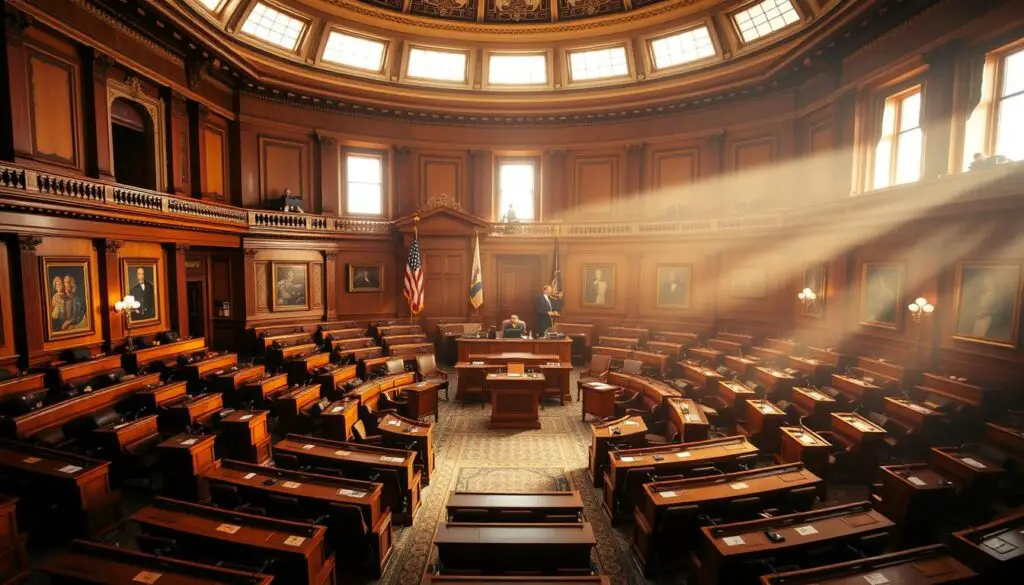Have you ever wondered how ancient scripture intersects with modern faith? For members of the Latter-day Saints, a unique connection exists between biblical narratives and tangible locations in America. One such place holds deep significance—the site believed to be the Garden of Eden, as revealed through early teachings.
According to historical records, Joseph Smith identified a location near Independence, Missouri (39.0997° N, 94.5786° W), as the original home of Adam and Eve. This revelation, documented in the 1830s, became a cornerstone of LDS heritage. The area symbolizes both spiritual beginnings and the faith’s pioneering efforts, later shaping communities like Salt Lake City.
Why does this matter today? The story isn’t just about theology—it’s about people. Early members faced challenges while establishing settlements tied to these sacred beliefs. Their journeys reflect a blend of divine guidance and human perseverance.
In this article, we’ll explore how scripture, history, and geography intertwine. From Joseph Smith’s visions to the practical realities of building a community, you’ll gain insights into a fascinating chapter of religious history.
Key Takeaways
- The LDS Church connects the Garden of Eden to a specific site in Missouri, per Joseph Smith’s teachings.
- This location (near Independence, MO) is tied to early 19th-century revelations and migrations.
- Adam and Eve’s narrative is central to the theological significance of the area.
- Historical efforts in the 1830s influenced later settlements, including Salt Lake City.
- The story blends ancient scripture with modern LDS beliefs and community-building.
Introduction to the LDS Garden of Eden Story
Stories of beginnings often shape how communities view their purpose. For members of the Church of Jesus Christ, the account of humanity’s origins isn’t confined to ancient scripture—it’s tied to a physical place with spiritual weight.
Overview of the Garden Narrative
Early teachings describe a lush setting where Adam and Eve made pivotal choices. According to Joseph Smith, this story unfolded not in the Middle East but near modern-day Missouri. His 1830s revelation, later included in the Doctrine and Covenants, framed the area as a sacred starting point.
Leaders emphasized both literal and symbolic meanings. While some saw the location as a historical marker, others focused on its lessons about growth and redemption. This duality allowed believers to connect personally with the narrative.
Why the Story Remains Relevant Today
For many, the tale isn’t just about the past—it’s a reminder of divine guidance. As one member shared, “Understanding our roots helps us navigate modern challenges.” The account also underscores themes like family bonds and spiritual resilience.
Scriptural references, combined with Joseph Smith’s visionary leadership, keep the story alive. It bridges ancient teachings with contemporary faith, offering hope and direction in uncertain times.
Historical Context of the Garden Narrative in Early Mormonism
How do historical events shape spiritual beliefs? For early Latter-day Saints, their journey to Missouri in the 1830s wasn’t just about finding new land—it became a defining chapter in their faith’s story. Settlements in Daviess County and Jackson County anchored their vision of a sacred homeland, though tensions soon arose.
Early Church Migration and Settlement in Missouri
By 1831, members began relocating to Missouri, drawn by revelations about its spiritual significance. Joseph Smith described the area as a “center place” for believers. Jackson County initially served as a gathering spot, but conflicts over land and cultural differences led to forced evacuations by 1833. Many regrouped in northern counties like Daviess, where they established farms and communities.
Impact of the 1838 Mormon War
Hostilities peaked in 1838 when Missouri officials ordered Latter-day Saints to leave the state. The conflict, later called the Mormon War, saw skirmishes, property destruction, and arrests. Over 10,000 people were displaced during winter months. One settler wrote, “We trusted divine guidance, even when hope felt scarce.”
These events deepened the community’s connection to their beliefs. The trials in Missouri reinforced ideas of perseverance tied to sacred history. While physical settlements faded, their legacy shaped later teachings about faith amid adversity.
Origins and Significance of the Garden Narrative in LDS Theology
How do scriptural narratives shape a community’s understanding of its purpose? For Latter-day Saints, the story of humanity’s origins is deeply rooted in both ancient texts and modern revelation. This blend creates a unique theological framework that continues to guide believers today.
Scriptural Foundations and Early Revelations
The Doctrine and Covenants provides key insights into this narrative. Section 107:53-56 describes Adam gathering his posterity at Adam-ondi-Ahman, a location later identified by Joseph Smith. These passages connect ancient events to specific geographic sites in America.
Early teachings emphasized that Adam and Eve’s choices were part of a divine plan. As Prophet Joseph taught, their actions enabled spiritual growth through mortal experience. This perspective reframed the fall not as failure but as a necessary step toward redemption.
The Symbolism of Choices and Growth
LDS theology views Adam and Eve’s story through a lens of intentional design. Their decision to partake of the forbidden fruit is often called a “fortunate transgression” – a choice that allowed humanity to progress. This interpretation appears in teachings from Brigham Young to modern leaders.
| Traditional View | LDS Perspective |
|---|---|
| Fall as disobedience | Fall as divine necessity |
| Focus on punishment | Emphasis on agency |
| Static creation story | Evolving spiritual journey |
Historical records show how early members applied these ideas. Journals from the 1830s describe settlers reflecting on Adam’s legacy while building communities. One wrote, “We are heirs to the same promises – to labor and become.”
Exploring the mormon garden of eden: Beliefs and Location
Sacred spaces often anchor spiritual identity, blending physical landscapes with divine purpose. For early Latter-day Saints, locating the Garden of Eden wasn’t just symbolic—it became a tangible expression of their faith’s roots. This connection between doctrine and dirt shaped how communities viewed their role in a broader narrative.

Defining the Sacred Geography
LDS tradition pinpoints the site near Independence, Missouri (39.0997° N, 94.5786° W), as humanity’s first home. Early records describe it as a lush valley where Adam and Eve began their mortal journey. Joseph Smith taught that this land held dual significance: a historical marker and a future gathering place for believers.
Joseph Smith’s Teachings on the Site
In 1838, Smith identified Spring Hill—later renamed Adam-ondi-Ahman—as central to this sacred geography. He linked the area to prophecies in the Book of Mormon, stating it would host pivotal events before Christ’s return. Settlers documented his emphasis on its spiritual and practical value, calling it “a refuge and a revelation.”
The site’s coordinates weren’t arbitrary. Smith connected them to visions of Adam blessing his posterity there. This blend of revelation and real-world mapping gave members a concrete link to scriptural promises. Today, these teachings continue to shape how Latter-day Saints view their relationship to both earth and eternity.
Revelation and the Sacred Designation of Spring Hill
How do sacred spaces gain their meaning? For Latter-day Saints, Spring Hill’s significance stems from divine guidance. In April 1838, Joseph Smith announced a revelation renaming the area Adam-ondi-Ahman. This “name given of the Lord” (Doctrine and Covenants 116:1) transformed it into a spiritual landmark.
The Role of Divine Revelation in Site Designation
Smith’s teachings tied the site to ancient prophecies. He described visions of Adam returning before the second coming, fulfilling the phrase “days shall sit in council” (D&C 107:53). These revelations framed the location as both historical and prophetic.
Insights from Doctrine and Covenants
The Doctrine and Covenants anchors Spring Hill’s sacred status. Its verses connect the land to Adam’s final blessings and Christ’s future reign. Early members saw this as proof that God actively guided their community-building efforts.
When settlers dedicated the area in 1838, they viewed it through this dual lens—a place of past beginnings and future promise. Today, these teachings remind believers that revelation remains central to understanding sacred spaces. As one historian noted, “It’s not just about where we’ve been, but where faith can lead.”
The Historical Role of Adam-ondi-Ahman in Mormon History
Gathering places often become the heartbeat of a community’s story. For early Latter-day Saints, Adam-ondi-Ahman wasn’t just a location—it was a living symbol of unity and divine purpose. Nestled in a quiet valley, this site bridged past promises with future hopes.
Its significance as a meeting place for patriarchs
Joseph Smith taught that this was the place where Adam gathered his family before his death. Early records describe it as a sacred space for blessings and counsel. One settler wrote, “Here, we felt connected to those who walked before us.”
The area’s importance extended beyond history. Leaders linked it to prophecies where the faithful would come visit people in preparation for Christ’s return. Scriptural phrases like “ancient days shall sit in council” (D&C 107:53) fueled this vision, blending tradition with anticipation.
Communal gatherings here strengthened bonds during turbulent times. Families held meetings, shared resources, and reaffirmed their commitment to building a righteous society. These efforts turned a Missouri hillside into a touchstone of faith—a reminder that sacred spaces shape both identity and destiny.
Debates over the Garden’s Location among Church Leaders
When sacred stories meet geography, debates often follow. Early Latter-day Saint leaders held diverse views about where humanity’s first home truly lay. These discussions reveal how faith and interpretation shaped their understanding of divine landscapes.
Perspectives From Brigham Young and Heber C. Kimball
Brigham Young strongly supported Joseph Smith’s Missouri designation, calling it “a revelation beyond dispute.” Yet others, like Heber C. Kimball, suggested symbolic meanings. He once mused, “Do we seek dirt or doctrine? The lesson matters more than the land.”
The Evolution of the Narrative
By the 1840s, some members questioned if Jackson County’s exact coordinates were essential. Journals show debates about whether the Garden Eden Jackson connection was literal or a metaphor for spiritual beginnings. One settler wrote, “The fall teaches us to grow—where it happened is secondary.”
These discussions mirrored broader tensions in LDS historiography. Were sacred sites fixed locations or evolving symbols? The book of Doctrine and Covenants fueled these conversations, with its blend of specific dates and open-ended prophecies. As one historian notes, “The question wasn’t about maps—it was about how revelation unfolds through time.”
Theological Interpretations of the Fall and Redemption
What if a mistake became a stepping stone? Latter-day Saint teachings reframe Adam and Eve’s story as essential to humanity’s growth. Unlike traditional views of the fall as tragic failure, LDS theology celebrates it as a divine catalyst.
The Fortunate Transgression: A Door to Progress
Early LDS leaders called this event a “fortunate transgression” – a choice that allowed children of God to gain mortal experience. As Elder Dallin H. Oaks taught, “Without that choice, we could never learn or become.” This perspective shifts focus from punishment to purpose.
Genesis Through an LDS Lens
While Genesis emphasizes consequences, LDS writings highlight agency. The Book of Moses adds context: Eve declares, “Were it not for our transgression, we never would have had seed” (Moses 5:11). This revelation transforms the narrative into one of deliberate design.
| Traditional Genesis Focus | LDS Emphasis |
|---|---|
| Disobedience | Necessary choice |
| Loss of paradise | Path to wisdom |
| Original sin | Personal responsibility |
This framework invites believers to see their part in God’s plan. As Adam and Eve embraced growth through challenges, members today view life’s trials as opportunities. The story becomes less about ancient guilt and more about modern hope – a reminder that Jesus Christ’s redemption makes all progress possible.
Comparing Mormon Perspectives with Mainstream Christian Views
Interpreting sacred texts often reveals deeper truths about a faith’s worldview. For Latter-day Saints, stories like the Garden of Eden carry layered meanings that differ from mainstream Christian teachings. These distinctions highlight how scripture shapes identity and practice.
Literal Narratives Versus Symbolic Lessons
Traditional Christianity often treats Genesis as allegorical, focusing on themes like sin and redemption. In contrast, the Church of Jesus Christ of Latter-day Saints emphasizes historical events. Joseph Smith taught that Adam and Eve’s choices occurred in a real place and time, shaping doctrines about human purpose.
Consider these key contrasts:
| Mainstream Christian View | LDS Perspective |
|---|---|
| Symbolic fall | Literal event enabling growth |
| Redemption through grace alone | Grace plus personal effort |
| No modern revelation | Ongoing guidance via prophets |
For example, the Book of Moses expands Genesis with details about Eve’s reasoning. This text, unique to LDS scripture, frames the fall as intentional rather than accidental. As one scholar notes, “It’s less about punishment and more about progression.”
Debates also surround Jesus Christ’s role in Latter-day Saint theology. While both traditions affirm His divinity, teachings about His latter-day ministry through modern prophets set the faith apart. These nuances show how interpretation bridges ancient texts and living belief.
Analyzing Historical Scripture and Revelation in Context
Understanding religious doctrine often requires balancing dusty archives with living faith. For Latter-day Saints, teachings emerge from both ancient texts and modern spiritual insights. This dynamic shapes how believers interpret sacred stories today.

Interpretations Drawn From Historical Documents
Early journals and letters reveal how leaders like Joseph Smith approached scripture. A diary entry from 1838 notes, “The book of Doctrine and Covenants clarifies truths hidden for ages.” These records show evolving views on topics like the day of judgment and human agency.
For example, early editions of the Doctrine and Covenants included revelations later refined through prayer. This process highlights how context shapes understanding. As one historian observed, “Scripture isn’t static—it breathes through time.”
The Interplay Between Modern Revelation and Ancient Texts
LDS teachings often blend biblical narratives with new insights. Consider these contrasts:
| Traditional Approach | LDS Method |
|---|---|
| Fixed interpretations | Evolving understanding |
| Closed canon | Ongoing revelation |
| Historical analysis alone | Divine guidance + history |
Smith’s translation of the Book of Abraham exemplifies this. By merging ancient papyri with spiritual impressions, he created a text that bridges eras. This approach encourages believers to seek personal meaning while honoring tradition.
Today, this balance remains vital. As doctrines develop, members weigh ancient wisdom against modern needs—a dance between old pages and new light.
Insights from Michael Austin and Contemporary Scholarship
Literary analysis often unveils hidden layers in sacred texts. Scholar Michael Austin explores how Lehi’s dream in the Book of Mormon reimagines Genesis themes. His work reveals fresh connections between ancient stories and LDS theology.
Lehi’s Dream as a Narrative Counterpoint
Austin notes that Lehi’s vision inverts traditional Eden motifs. While Genesis focuses on Adam and Eve leaving paradise, Lehi’s journey emphasizes seeking divine truth.
“The tree of life becomes a symbol of active pursuit, not passive obedience,”
he writes. This shift reflectsJoseph Smith’s emphasis on personal revelation.
Key contrasts include:
- Forbidden fruit vs. freely offered nourishment
- Exile from Eden vs. invitation to eternal life
- Serpent’s deception vs. Christ’s clarity
Modern Scholarship Meets Traditional Teachings
Historical criticism examines how cultural contexts shaped these texts. Austin argues that Lehi’s story responds to 19th-century questions about agency and redemption. This aligns with Joseph Smith’s revelations in the Doctrine and Covenants, which frame the fall as purposeful.
| Traditional Genesis Focus | Lehi’s Dream Emphasis |
|---|---|
| Loss of innocence | Gained understanding |
| Divine judgment | Merciful guidance |
| Static paradise | Progressive journey |
Such insights don’t negate LDS teachings—they deepen them. As Austin observes, “Stories evolve because truth speaks to every generation.” This balance between scholarship and faith keeps ancient narratives alive today.
Sacred Geography and Modern Mormon Identity
Physical spaces often become bridges between generations. For Latter-day Saints, historic sites like Salt Lake City aren’t just landmarks—they’re living connections to shared beliefs. These places anchor identity, blending ancient stories with present-day faith.
Pilgrimage to Historic LDS Sites
Every year, thousands come visit people at locations tied to their heritage. Salt Lake City’s Temple Square remains a top destination, drawing families seeking spiritual renewal. One visitor shared, “Walking where early members sacrificed reminds us what matters.”
These journeys strengthen community bonds. Parents teach children about pioneers who shaped the land, turning history into personal legacy. Sites like Adam-ondi-Ahman in Missouri also attract reflection, though fewer visit due to distance.
How Modern Members Relate to Ancient Narratives
Sacred geography evolves with time. While early settlers focused on literal sites, many today see symbolic value. As one leader noted, “Our home isn’t just dirt—it’s how we live the teachings.”
Families often reinterpret stories like Eden’s location through daily choices. Service projects or temple visits become modern acts of faith, mirroring ancestors’ dedication. This approach keeps ancient narratives relevant without losing their power.
Rituals and gatherings honor these ties. Annual events in Utah’s state parks celebrate pioneer resilience, blending history with hope. Through such practices, sacred spaces remain vibrant parts of a living tradition.
Conclusion
Sacred stories shape communities, blending past lessons with future hopes. The Garden narrative anchors LDS identity, tying ancient scripture to real-world journeys. Through debates over Jackson County’s role and modern scholarship, believers see both history and symbolism in their faith’s roots.
Leaders like Joseph Smith emphasized divine revelation, as seen in the Doctrine and Covenants. These teachings framed sites like Adam-ondi-Ahman as bridges between time and eternity. While early settlers sought literal connections, many today find deeper meaning in the fall’s spiritual lessons.
Prophecies about the second coming and gatherings in Missouri remind members that sacred geography evolves. Jesus Christ’s teachings, paired with modern insights, show how scripture adapts to each generation’s needs.
From Salt Lake City to quiet valleys, these stories inspire action. As families reflect on their part in this legacy, they carry forward a truth: faith thrives where history and hope meet.
FAQ
Where do Latter-day Saints believe the Garden of Eden was located?
According to teachings by Joseph Smith, the prophet founder of the Church of Jesus Christ of Latter-day Saints, the original site is linked to Jackson County, Missouri. A later revelation identified Spring Hill in Daviess County, Missouri, as Adam-ondi-Ahman—a gathering place for ancient patriarchs.
How did early Church leaders connect Adam-ondi-Ahman to the Garden narrative?
Joseph Smith taught that Adam-ondi-Ahman held prophetic significance as a sacred meeting place before the Second Coming. This belief stems from revelations in the Doctrine and Covenants, which describe the valley as a site where Adam blessed his posterity.
Why is the concept of the “Fall” viewed differently in LDS theology?
The Church emphasizes Adam and Eve’s choice as a necessary step for humanity’s growth, often calling it a “fortunate fall.” This contrasts with some Christian interpretations of the Fall as purely tragic, highlighting LDS teachings on redemption through Jesus Christ.
How do modern scholars analyze the Garden narrative in LDS history?
Scholars like Michael Austin explore parallels between Lehi’s vision in the Book of Mormon and Genesis. Their work examines how early revelations and frontier experiences shaped the Church’s unique perspective on sacred geography.
What role does Adam-ondi-Ahman play in LDS beliefs about the Second Coming?
Members believe Adam-ondi-Ahman will host a grand council before Jesus Christ’s return, as prophesied in Daniel 7:13–14. This ties into Joseph Smith’s teachings about the site’s role in uniting past and future dispensations.
How did the 1838 Mormon War impact early Church settlements in Missouri?
Conflicts with Missouri settlers forced members to abandon lands like Jackson and Daviess counties. These events deepened the spiritual significance of Missouri as a “New Jerusalem” and a place of promised gathering.
Do all Latter-day Saints interpret the Garden story literally?
While many embrace a literal reading, others focus on symbolic lessons about agency and progression. Official teachings affirm Adam and Eve as historical figures, but individual perspectives vary on details like the site’s modern location.
Why is Spring Hill in Missouri considered sacred?
Joseph Smith designated Spring Hill as Adam-ondi-Ahman through revelation in 1838. The area is tied to prophecies of Adam’s return and Christ’s millennial reign, making it a key part of LDS eschatology.
How do modern members engage with historic sites like Adam-ondi-Ahman?
Some visit Missouri as part of religious heritage tours, reflecting on early Church history. These pilgrimages reinforce connections to scriptural narratives and the sacrifices of early Saints.
What’s the difference between LDS and mainstream Christian views on Adam and Eve?
The Church teaches that Adam and Eve’s choices were intentional and essential, leading to mortal experience and redemption. This contrasts with some traditions that emphasize sin’s consequences over its role in God’s plan.








